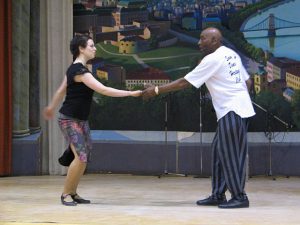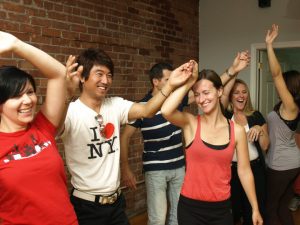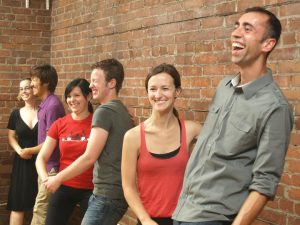
People contact me regularly asking advice about how to teach Beginner Swing Dance classes. I’ve been teaching for a long time, since 1999, and I can’t really even guess just how many Beginner Lindy Hop lessons I’ve taught throughout the years. From about September 2009 to May 2014, I taught a minimum of 3 Beginner lessons a week, often more, and I truly love to welcome new people to the dance. It’s incredibly rewarding!
Teaching for all these years has also been a great learning process. It’s a joy to teach adults their first dance steps and to give them that first taste of what Lindy Hop is all about.
My teaching evolved over time. I used to teach very differently than I do now. After working with Frankie and observing Beginner classes all over the world, and as a result of my own lessons and watching the cause and affect of my actions, I completely changed my approach to teaching.
What is the Goal of a Beginner Swing Dance Lesson?
Ultimately, my focus shifted because I began to identify the real goal of the Beginner lessons. Around 2006 I completely changed my mind about what the actual goal of the first Beginner Swing Dance lesson actually is. Before 2006 I had the mentality that it was about “getting it right, straight from the beginning” and that mindset made me want to get into a lot technique, connection work, and detailed information. I’ve since thrown all that out the window in my Beginner lessons.
I’ve come to understand that no matter how great of a first lesson you teach, only a certain percentage of people will continue beyond that first lesson. An even smaller percentage of those students will continue past the 6-8 week mark. This is (usually) not the fault of the instructors or the lessons. Though it remains a mystery to me as to why not everyone falls in love with Lindy Hop, not everyone will get hooked. I’ve come to accept that the world is made up of two kinds of people; Lindy Hoppers (even if they don’t know it yet) and everyone else. It took me a long time to understand that and to feel that that’s ok. C’est la vie.
So what is the goal of the first lesson? Once you bring people through the door, it’s your big chance — and sometimes your only chance — to give people a taste of what Lindy Hop is all about. For the people who are meant to become Lindy Hoppers, that first lesson is the chance to capture their hearts with the spirit of the dance. And for those people who aren’t going to get hooked, I still want them to have a nice memory and clear picture of what this wonderful dance is all about.
The Lindy Hop Spirit
 It’s not about the steps. The spirit of the dance is paramount. That spirit is not encapsulated in the technique, moves, and precise details that experienced dancers feel compelled to share. It’s not about footwork, or specific concepts about connection. As contemporary Lindy Hoppers, we really need to step back and remember that during the swing era nobody went to a dance studio to learn. People went to a dance hall, they were inspired by the incredibly popular music of the time, and they created new ideas and copied one another to express that music on the social dance floor. Everything was guided by the energy of the music and the people dancing around them. It was about feeling the music, feeling a nice stretchy connection with your partner, and creating shapes together. The dance was exciting, it was infectious, it was a bit wild, and it was FUN.
It’s not about the steps. The spirit of the dance is paramount. That spirit is not encapsulated in the technique, moves, and precise details that experienced dancers feel compelled to share. It’s not about footwork, or specific concepts about connection. As contemporary Lindy Hoppers, we really need to step back and remember that during the swing era nobody went to a dance studio to learn. People went to a dance hall, they were inspired by the incredibly popular music of the time, and they created new ideas and copied one another to express that music on the social dance floor. Everything was guided by the energy of the music and the people dancing around them. It was about feeling the music, feeling a nice stretchy connection with your partner, and creating shapes together. The dance was exciting, it was infectious, it was a bit wild, and it was FUN.
I started to understand what that the priority 0f that “first touch” with students should really be about; giving people a clear picture of the dance and especially the feeling and the spirit of Lindy Hop. In that first lesson, my goal is now to capture their hearts with the soul of the dance. I shape everything around that idea. It’s the best way to hook them to continue, and even if they don’t continue, they’ll still be left with a clear memory of what Lindy Hop is all about. They wouldn’t have had that exposure if I had spent the lesson working too much on footwork or connection concepts.
Now I give them a first class “experience” where they get an idea of what Lindy Hop. I tell them about the roots of the dance, about the Savoy Ballroom in Harlem, and about how the dance developed. I remind them that they should be giggling and not taking themselves too seriously and that nobody took dance lessons back in the day. I use as few words as possible and instead play a lot of music and let them play around with shapes, twisting around, cool breeze in the knees, pecking. I don’t give the students time to overthink it, I just get them moving. If they stick with the lessons, then later on we get into other details, but that isn’t the focus of the Beginner lesson anymore. The primary objectives are to get them to feel the music, to feel their partners, to laugh, and to have a good time.
Beginner Class Focus
 When I teach, I focus on keeping the energy up, rotating a lot, not too much talking and a lot of doing, and getting people social dancing to the music as much as possible. Ideally, I start with a warm up with music and then I try to get the music playing frequently by the second half of the class while they play and practice. The sooner I can get the music back on again after the warm up, the better.
When I teach, I focus on keeping the energy up, rotating a lot, not too much talking and a lot of doing, and getting people social dancing to the music as much as possible. Ideally, I start with a warm up with music and then I try to get the music playing frequently by the second half of the class while they play and practice. The sooner I can get the music back on again after the warm up, the better.
My Other Important Advice
- If you have fun, they’ll have fun! Your smiles, laughter, and general happiness can be contagious. Similarly, if you’re not enjoying teaching Beginner classes then you should really evaluate yourself and why you’re teaching.
- Do a simple warm up with music, preferably in a circle.
- In classes with fewer than 30 people, do a quick ice breaker.
- Give some historical background about the dance. “Lindy Hop is the original swing dance created by the black dancers in Harlem, New York at dance halls like the Savoy ballroom. It was inspired by the popular swinging jazz music of the era and was danced from the late 1920s until just after WWII.”
- More music, less talk.
- Learn to “sing” when you count. Practice counting in with rhythm and swing in your voice. Your voice should instill the _swing_ into them.
- Volume is important. If you don’t have a loud enough voice, invest in a good wireless microphone. It’s hard to build energy in the room or to really make students feel comfortable if they’re straining to hear your voice.
- Rotate often.
- Beware of couples. That “rotate often” advice goes 10 fold when you see that people have come back together in rotation as a couple. About 75% of the time, one of the people in the relationship has dragged the other person to the dance lesson and people behave differently when they get back to their romantic partner. These Beginners will often get neurotic when they return to their boyfriend, wife, etc. Keep an eye on who arrived together and avoid keeping them together too long.
- Require everyone to rotate. Rotating is part of the Lindy Hop culture. Don’t make exceptions for Beginners who want to stay together. It never works out in the long run. If they don’t want to rotate then Lindy Hop probably isn’t for them anyway. You can suggest private lessons instead.
- Avoid negative examples. Avoid mentioning any “don’t do this” advice and stick to what they should do.
- Always suggest that the dance is fun and easy and not to over think it. Never tell them that a move is “hard” or you’ll impose that idea on them. Keep it fun and if they struggle, remind them that it’s their first class, they’re doing a great job, and it gets easier with practice. Keep it light hearted.
- Name drop. Tell your students about Frankie Manning and the dancers of the Savoy. Mention musicians that students should listen to. Great suggestions for Beginners are Ella Fitzgerald, Louis Armstrong, and Fats Waller.
- Organize a good music playlist in advance that’s clear and swinging for Beginners. Here are some suggestions. My beginner playlists are not necessarily made up of my very favourite songs but instead focus on a clear beat and a good tempo.
- Get them social dancing from Day 1. After they’ve learned 2 or 3 moves, try to put on the music straight away and give them the idea of leading and following and playing around with each other in a light-hearted way to the music.
- End on a high note with music and big applause.
BEGINNER LINDY HOP – Review Videos
Here are some videos that show what I teach and when. The videos make it seem like my lessons are more technical than they actually are and that’s because these are meant as review videos, not for teaching the first time.
8 Count Month
Beginner Swing – Week 1
Beginner Swing – Week 2/3
There are more videos including our Charleston material here. You might also want to have a peak at our Curriculum lists.
It’s totally up to you what you decide to teach, but maybe you’ll find my experience with this helpful. Time has changed my mind and led my classes in a new direction. Maybe you’ll prefer this methodology too. I wish you luck!
Mandi Gould
Director, Head Dance Instructor
Bees’ Knees Dance – Anyone Can Dance™